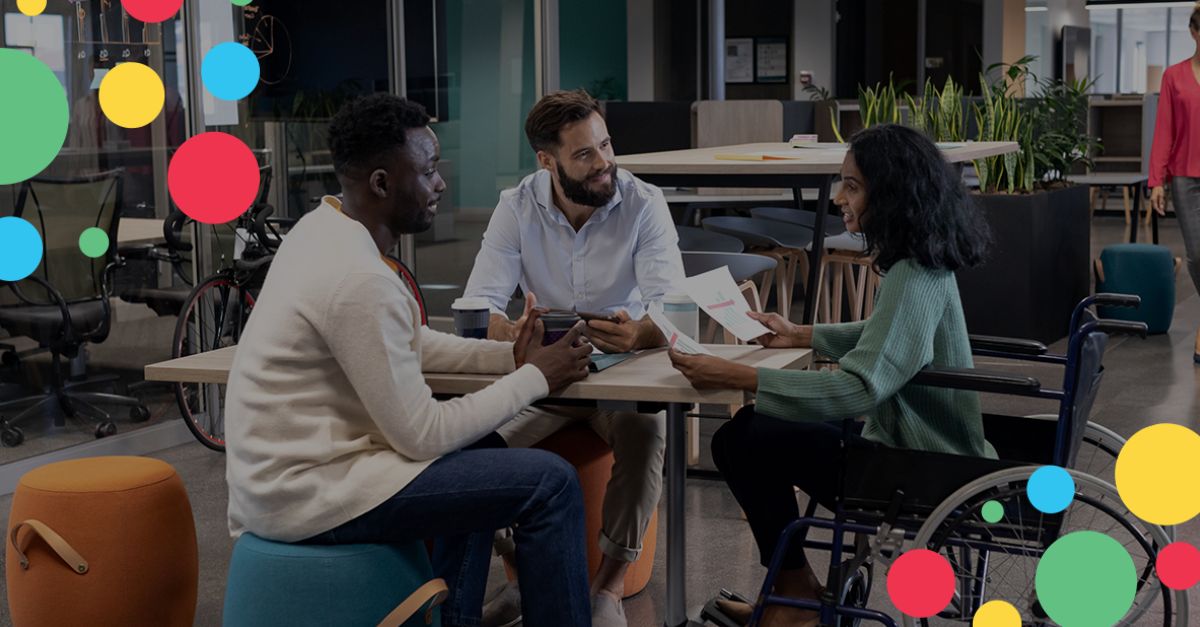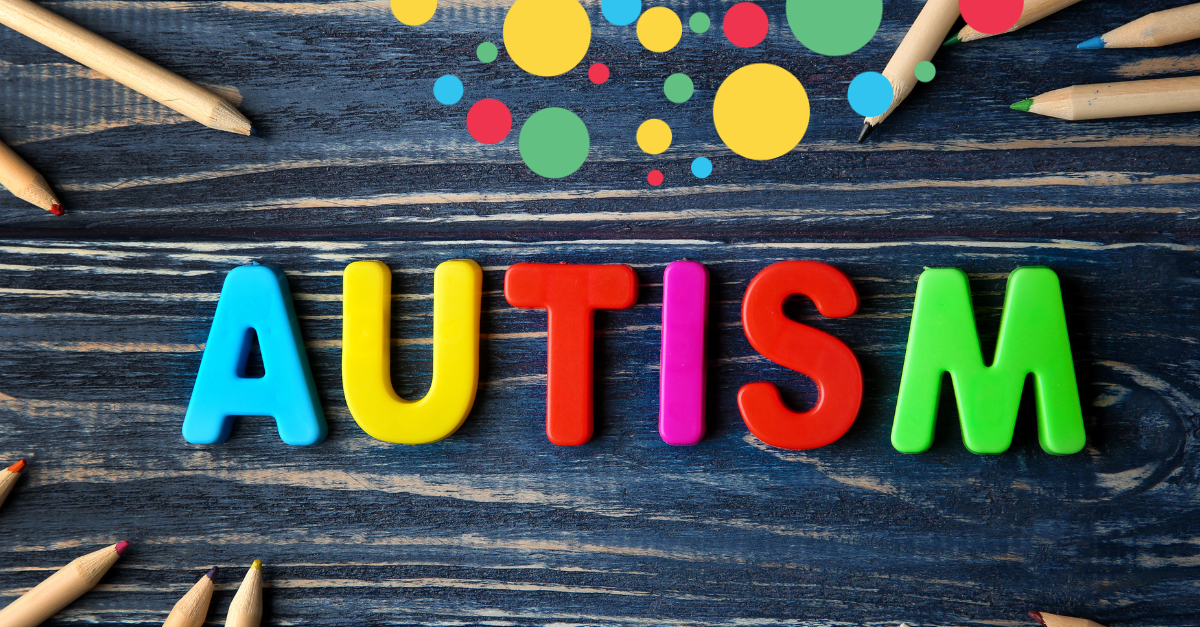Many employers have committed to better representation and diverse, equitable, and inclusive workplaces. While there are many ways to approach this challenge, talking about the goal is only the first step. These commitments must be followed by action. Fortunately, diversity and inclusion best practices are available to organizations that want to create real change.
Diversity and inclusion isn’t a monolith. Diversity comes in numerous forms. Inclusion is the result of people being accepted and included within the culture for who they are. Fostering these practices is about processes, people, and culture. It’s not HR’s job alone; you need buy-in from executive leadership and participation from everyone within the organization.
Learn about what diversity and inclusion mean in the workplace, the common challenges organizations face, and how to promote inclusion and diversity using Whole Brain® Thinking.
Understanding Diversity and Inclusion
You’ve heard people talk about workplace diversity and inclusion, but do you know what that means?
Diversity is a term often discussed in terms of racial representation. That’s one example. More broadly, diversity refers to individual differences among populations that relate to physical characteristics, personality aspects, and identity.
If diversity represents existing characteristics, inclusion is action-oriented. “Inclusion describes the extent to which each person in an organization feels welcomed, respected, supported and valued as a team member,” according to the Society for Human Resource Development.
Inclusion requires an ongoing effort to build, maintain, and evolve.
Critical Differences Between Diversity and Inclusion
When we talk about diversity and inclusion, diversity comes first because it is more visible and apparent to many people. Organizations can catalog and count how diverse they are based on numerous characteristics.
Numbers don’t easily define inclusion. Simply assembling a diverse team doesn’t mean you have a more inclusive workplace. Inclusion requires a culture that welcomes, accepts, and celebrates people for who and what they are.
While workplace diversity can exist without inclusion, inclusion doesn’t exist without diversity.
What Kinds of Diversity Are There?
Diversity takes numerous forms, including federally protected characteristics such as race, gender, and sexual orientation. But many aspects of diversity encompass characteristics, backgrounds, experiences, and thinking processes.
Race, gender, ethnicity, and sexual orientation are common categories of diversity, along with neurodiversity, class, culture, and cognitive diversity.
Categories of workplace diversity you should be aware of include:
- Age diversity:Refers to the range of ages in the workplace.
- Class/socioeconomic status diversity: Refers to differences based on perceived social class, income, wealth, and status.
- Cognitive diversity: Refers to people’s different thinking processes, methods, and perspectives.
- Cultural diversity: Refers to people’s various ethnicities, customs, religions, languages, and traditions.
- Disability diversity: Refers to people who experience disabilities, impairments, or chronic conditions.
- Gender and sexual orientation diversity: Refers to the umbrella of ways people identify in terms of gender and sexual orientation.
- Neurodiversity: Refers to neurological differences in how people perceive, learn, and interact with each other.
- Racial diversity: Refers to people’s grouping based on perceivable physical traits.
- Religious diversity: Refers to people’s identity with religious or spiritual beliefs, and those without such beliefs.
When discussing diversity, remember that everyone has a unique combination of characteristics and experiences that make them who they are.
Common Challenges Facing Diversity And Inclusion Efforts
Achieving diversity is challenging enough for many organizations, much less going to the next step and building inclusion within a diverse workforce. Here are some of the challenges organizations face.
Unsupportive Leadership
Diversity and inclusion starts at the top, with executive buy-in and who owns the initiative. Does the responsibility for diversity and inclusion live in the C-suite, whether through HR or a standalone position? What kind of budget does this initiative have?
If leaders aren't willing to embrace diversity and inclusion, you’ll struggle to gain traction. Employees will recognize that it isn’t a priority. They might not feel safe supporting such efforts, either.
Resistance From Employees
Employee resistance is one of the most common challenges when implementing diversity and inclusion efforts in the workplace. This resistance can come in various forms, such as a refusal to participate in training, negative attitudes toward co-workers of different backgrounds and characteristics, and overt bias.
This resistance can come from numerous places: fear of losing status, ignorance, a lack of empathy, or even bigotry.
Unconscious Bias
Everyone has some level of unconscious bias based on their lived experiences and backgrounds. These implicit biases are within all of us and aren’t always easy to recognize or correct.
One way this can show up is during the hiring and promotion processes. These hiring managers and executives might not be deliberately discriminating against candidates of specific characteristics or backgrounds. But they might default to unscientific traits to decide, such as people who went to their alma mater or who have similar non-work interests.
Difficulty Measuring Progress and Success
Diversity can be measured at a high level fairly easily. By tracking your employee population along with characteristics including race and gender, you can see where you stand and whether you’ve improved over time.
Inclusion is more challenging to measure, as there’s no one-size-fits-all metric. And diversity and inclusion alike can suffer when your organizational goals are unclear or superficial.
For example, if your goal is to increase racial diversity by 20% among your engineering team, you might easily hit that number. But that success isn’t the whole picture. Do those employees feel included within their teams and the larger organization? Do new hires stick around or quickly quit? Are they getting the same opportunities for advancement? Do you practice pay equity?
These are just some questions you must ask if you want an accurate picture of your diversity and inclusion progress.
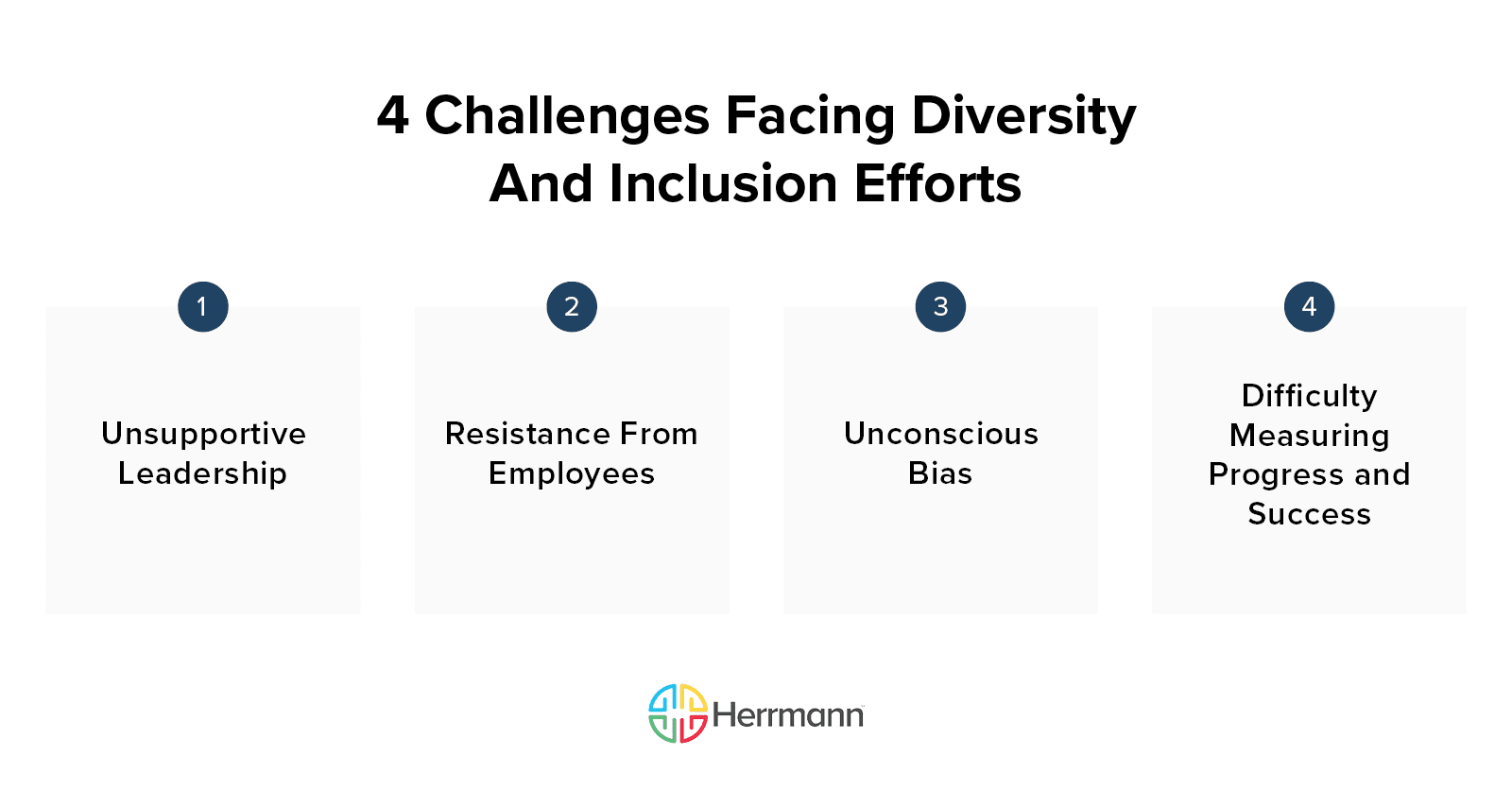
Assessing Your Organization's Diversity and Inclusion Progress
The first step in assessing an organization’s diversity and inclusion is to complete a company audit. Look at existing data related to demographic data, such as gender, race, ethnicity, age, and other demographic variables. But also make sure you collect data related to the employee experience, such as work satisfaction, job performance, retention rates, and leadership opportunities.
Augment this raw data with surveys, focus groups, and one-on-one feedback conversations. Talk with employees and other stakeholders to learn how they view diversity and inclusion in your organization. This effort expands your data set and gives you greater context as you devise a strategy.
After collecting data, look at the differences and disparities in your organization. At this point in the audit, patterns in demographic data, employee outcomes, or engagement can illustrate strengths, deficiencies, and opportunities.
After analyzing and interpreting the data, you can provide recommendations for improvement. These can include changes in recruitment and hiring, training, or cultural practices — all to promote a more diverse and inclusive workplace.
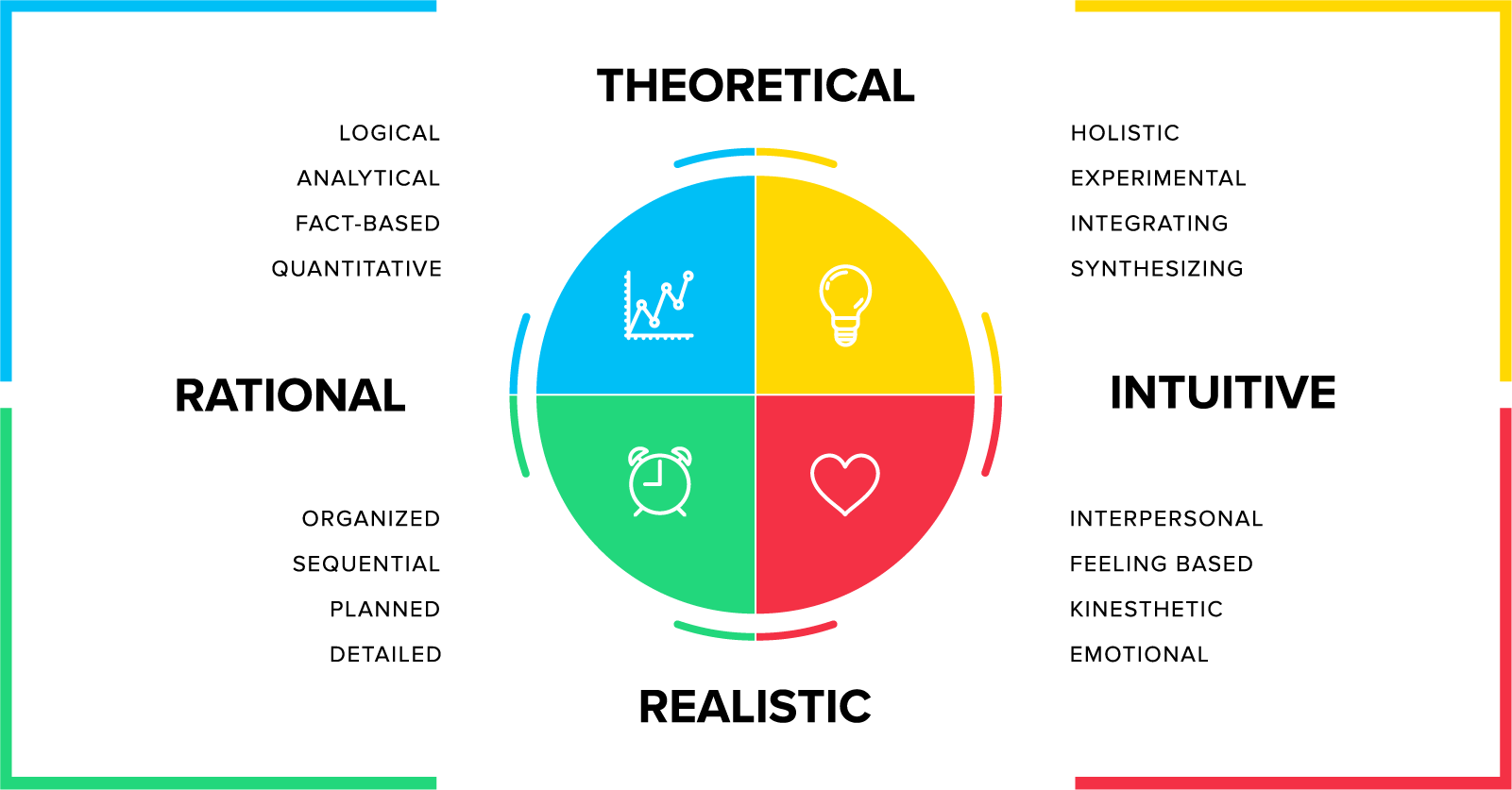
The Whole Brain® Approach to Diversity and Inclusion in the Workplace
Herrmann’s Whole Brain® Thinking model is a powerful tool for unlocking cognitive diversity within your team and helping employees become more considerate and inclusive of other thinking preferences. The lessons within this approach can also inform your more significant efforts to add diversity and instill inclusion.
The Whole Brain® Thinking model is a framework that groups thinking preferences in four quadrants: analytical (A, blue), structural (B, green), relational (C, red), and experimental (D, yellow). Organizations are most effective when they use all four quadrants of the brain in their thinking processes.
Everyone has a different mix of preferred thinking preferences, although we use all four quadrants daily. While we gravitate toward certain styles, there’s no “good” or “bad” way of thinking.
Another way to think of Whole Brain® Thinking is in terms of what (Blue), how (Green), who (Red), and why (Yellow). When you promote diversity of perspectives and thinking within your team, you have a better chance at embedding inclusion into the company’s mission, values, culture, and daily practices.
Here are several diversity and inclusion in the workplace ideas you can combine with Whole Brain® Thinking.
Set Diversity and Inclusion Goals
Start by asking why you’re trying to create a more diverse and inclusive environment. While your reasons might include a moral component, can you explain why this effort is suitable for your stakeholders and the business? Goals that align with business objectives are easier to communicate — and easier to defend at budget time.
Once you identify the gaps in your diversity and inclusion, it’s crucial to figure out how you'll close them. Perhaps you’ll hold trainings and workshops, or update your hiring and recruiting practices. Whatever your goals, be transparent about the process and encourage stakeholder input.
Educate Your Employees Through Training
Improving diversity and inclusion is about changing habits and prioritizing different behaviors than what your organization has always done. You usually need training to get employees to change their mindsets and actions.
Training is especially important because of the cognitive bias all of us have. Make sure the training program is geared toward employees across the organization and is an ongoing initiative. It’s a good idea to create action plans, encourage open dialog, and regularly check on progress.
Employees will respond to certain training methods depending on their thinking preferences. For example, employees who fall into the Blue or A quadrant might react to facts and statistics about the benefits of diversity. Meanwhile, employees who fall into the Green or B quadrant might be looking for concrete plans as to how you’ll improve diversity and inclusion.
Promote Accessible Design
When creating an accessible design for diversity and inclusion, you must consider the needs of everyone. Examples include, but aren’t limited to:
- People with disabilities.
- People from various cultural backgrounds
- People with different levels of ability.
Keeping the Whole Brain® Thinking approach in mind, you want to create design elements and content that encourage the different ways people learn and process information. This can be a very Red exercise, as you’re considering the impact on the people affected — especially those excluded by design and content that doesn’t consider their needs.
A few elements of accessible and inclusion design include using:
- High-contrast colors and larger text sizes to ensure the content is visible to people with visual impairments.
- Accessible color palettes to ensure people with color vision deficiency are included.
- Alt text for images and videos, so people with visual impairments can access the content.
- Captions for video content and transcripts for audio content to accommodate people’s needs.
- Translations, where applicable, to reach employees whose first language is different from the dominant language inside your organization.
You’ll likely find that accessible design is also desired by your clients, customers, or users. By instilling its importance in your workforce, you increase awareness and inclusion internally and externally.
Create a Diversity and Inclusion Council
Diversity and inclusion councils take many forms. But usually, you’ll need to answer these key questions:
- What are we creating? (Blue)
- How will this council operate? (Green)
- Who'll be on the council? (Red)
- Why are we doing this? (Yellow)
The first thing to do is understand your involvement. What will this council be doing? How will you measure progress? Your Blue thinkers want to quantify its impact, which can be challenging with culture-changing efforts like diversity and inclusion.
As you’re defining this council, some stakeholders will wonder what the structure and processes will be, as well as the timeline. You want to show these Green thinkers how the council will be organized and governed. Document everyone’s roles and responsibilities and what they plan on accomplishing.
Red thinkers are deeply concerned about the interpersonal effects. They’ll want to know who is on the council and how its efforts will affect the underrepresented or excluded populations. They’ll also want to know about the makeup of the council. While Blue thinkers might gravitate to the raw data around your council’s diversity, Red thinkers will ask about how the council’s makeup inspires trust — or doesn’t — among employees.
Finally, while people might agree about the worthiness of diversity and inclusion, they might wonder why a council is the right move. You need to define for stakeholders, especially Yellow thinkers, the purpose of the council — and its potential. How can this council innovate in unique ways? What makes it essential?
Evaluate Your Leadership Team
Are your executives and board members on board with improving diversity and inclusion? Who’s resistant to change? You need to ask these questions before getting started with organization-wide initiatives.
It’s also essential to examine how diverse your leadership team is. What perspectives do you have, and what perspectives are you missing? As you analyze your executive diversity, look at characteristics such as race and gender, and the technical skills and thinking preferences these leaders bring.
Suppose your leadership team is heavily indexed in the Yellow (D) and Red (C) quadrants, for example. In that case, you might need help unlocking the analytical (Blue) and planning (Green) aspects that come with running a company.
Understanding your leadership team’s thinking preferences reveals their diversity and readiness to promote diversity and inclusion throughout the organization.
Overcome Hiring Bias
Whole Brain® Thinking isn't a hiring or candidate assessment model. But its principles can inform your hiring efforts, including the skills you look for and the interview questions you ask.
Every job role has specific requirements, but many job postings call for characteristics that aren’t particularly important or are even discriminatory. At best, these extraneous requirements — such as seeking college degrees for nontechnical roles or five years’ experience for an entry-level job — discourage qualified candidates from applying.
Apply Whole Brain® Thinking to assess candidates more holistically. Look beyond the traditional resume and cover letter and consider potential, enthusiasm, creativity, emotional intelligence, and problem-solving skills.
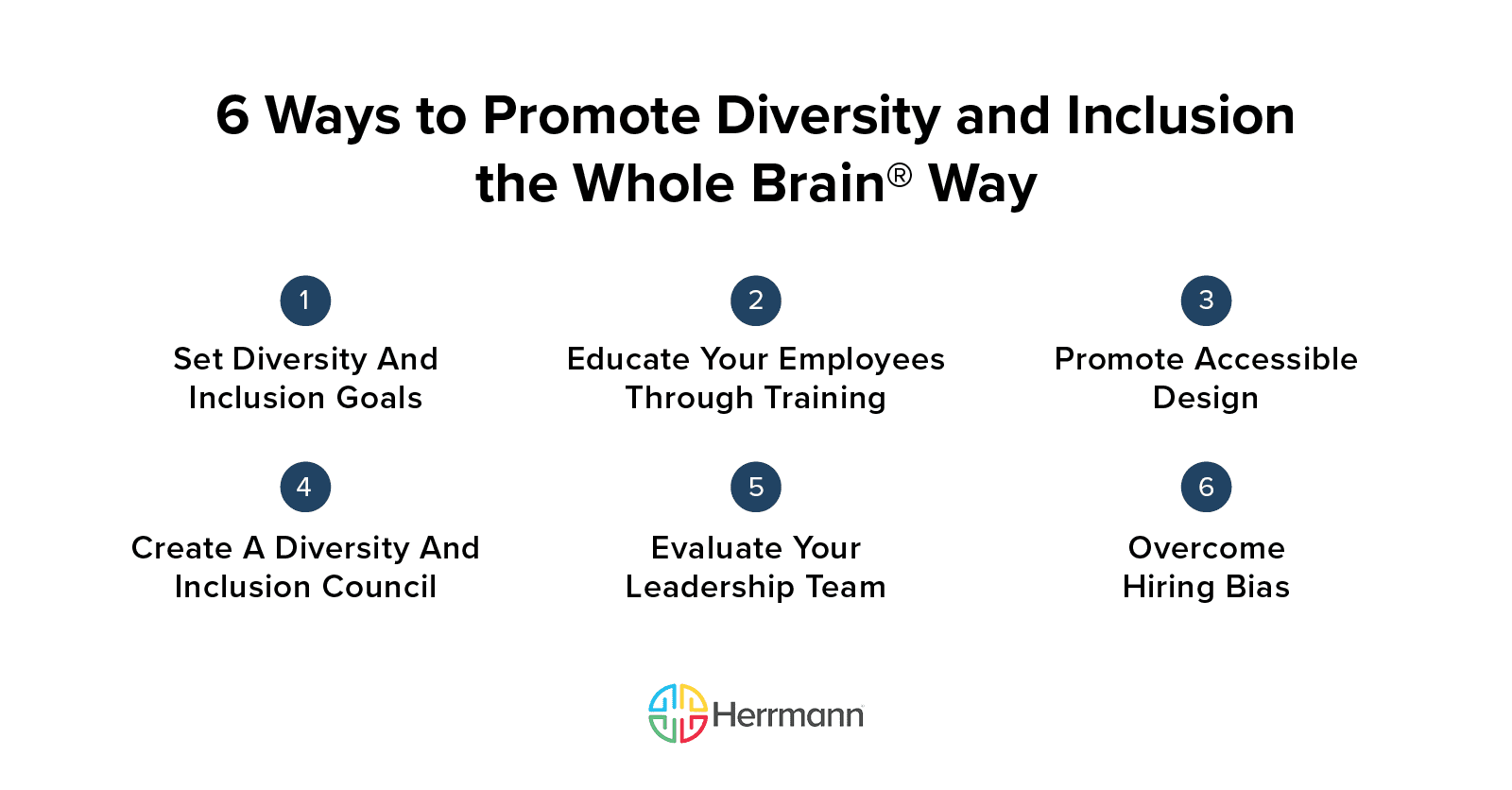
Diversity and Inclusion Are the Future
Most companies have long struggled to figure out how to improve diversity in the workplace, even after making public commitments. And even when they improve their numbers, they realize that inclusion is a formidable, yet worthy, challenge.
Becoming more diverse and inclusive requires intentional changes in your culture, practices, and thinking. You should view the challenge as a perpetual activity rather than a static, one-off goal. Whole Brain® Thinking can be a powerful ally, as it already fosters cognitive diversity and promotes the inclusion of different thinking preferences and perspectives.
Use these diversity and inclusion best practices to improve employee engagement, thinking, morale, productivity, and results in your organization.
Want to learn more? Discover the answer to “What Does Diversity Have to Do with Innovation?”


